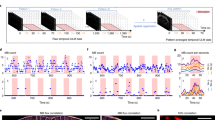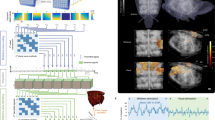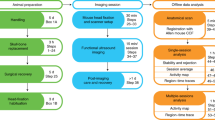Abstract
We present functional ultrasound (fUS), a method for imaging transient changes in blood volume in the whole brain at better spatiotemporal resolution than with other functional brain imaging modalities. fUS uses plane-wave illumination at high frame rate and can measure blood volumes in smaller vessels than previous ultrasound methods. fUS identifies regions of brain activation and was used to image whisker-evoked cortical and thalamic responses and the propagation of epileptiform seizures in the rat brain.
This is a preview of subscription content, access via your institution
Access options
Subscribe to this journal
Receive 12 print issues and online access
$259.00 per year
only $21.58 per issue
Buy this article
- Purchase on Springer Link
- Instant access to full article PDF
Prices may be subject to local taxes which are calculated during checkout


Similar content being viewed by others
References
Szabo, T.L. in Diagnostic Ultrasound Imaging: Inside Out 366–376 (Elsevier Academic Press, 2004).
Montaldo, G., Tanter, M., Bercoff, J., Benech, N. & Fink, M. IEEE Trans. Ultrason. Ferroelectr. Freq. Control 56, 489–506 (2009).
Bercoff, J. et al. IEEE Trans. Ultrason. Ferroelectr. Freq. Control 58, 134–147 (2011).
Fink, M. & Tanter, M. Phys. Today 63, 28–33 (2010).
Rubin, J.M., Bude, R.O., Carson, P.L., Bree, R.L. & Adler, R.S. Radiology 190, 853–856 (1994).
Bonnefous, O. & Pesqué, P. Ultrason. Imaging 8, 73–85 (1986).
Fung, Y.C. in Biomechanics: Circulation 2nd edn., 275–283 (Springer, 1997).
Kleinfeld, D., Mitra, P.P., Helmchen, F. & Denk, W. Proc. Natl. Acad. Sci. USA 95, 15741–15746 (1998).
Jensen, K.F. & Killackey, H.P. J. Neurosci. 7, 3544–3553 (1987).
Nicolelis, M.A. & Chapin, J.K. J. Neurosci. 14, 3511–3532 (1994).
Yang, X., Hyder, F. & Shulman, R.G. Proc. Natl. Acad. Sci. USA 93, 475–478 (1996).
Logothetis, N.K. Nature 453, 869–878 (2008).
DeSalvo, M.N. et al. Neuroimage 50, 902–909 (2010).
Busija, D.W., Bari, F., Domoki, F., Horiguchi, T. & Shimizu, K. Prog. Neurobiol. 86, 379–395 (2008).
Drew, P.J. et al. Nat. Methods 7, 981–984 (2010).
Angelsen, B.A.J. in Ultrasound Imaging Vol. 2, 10.3–10.46 (Emantec, 2000).
Paxinos, G. & Watson, C. The Rat Brain in Stereotaxic Coordinates 4th edn. (Academic Press, New York, 1998).
Mostany, R. & Portera-Cailliau, C. J. Vis. Exp. 12, 680–681 (2008).
Acknowledgements
We thank A. Urban for helpful comments on the manuscript and for technical advice on surgery and T. Montaldo for critical editorial comments on the manuscript.
Author information
Authors and Affiliations
Contributions
M.B., M.F. and M.T. conceived and initiated the project; M.T. supervised the project. E.M., G.M. and I.C. designed and performed experiments; E.M., G.M. and M.T. wrote the manuscript.
Corresponding author
Ethics declarations
Competing interests
The authors declare no competing financial interests.
Supplementary information
Supplementary Text and Figures
Supplementary Figures 1–3 and Supplementary Notes 1 and 2 (PDF 570 kb)
Supplementary Video 1
Video showing changes in cerebral blood volume during induced epileptiform activity (4AP injection) imaged by fUS. The epileptiform activity is recorded during 1 hour with a short control time at the beginning (baseline). The video displays the variation in Power Doppler relative to the baseline in a color scale ranging from - 50% (blue) to + 50% (red), superimposed on a control Power Doppler image. fUS acquisitions are performed every 3s. The injection site is represented by a green circle and the time relative to injection is displayed in the video. The blood volume response to onset and propagation of hyperactivity is visualized from the injection site to other brain regions. (MOV 2961 kb)
Supplementary Software
Implementation of fUS. A guide describes ultrasound sequences and signal processing. Code and data example are also provided. (ZIP 4681 kb)
Rights and permissions
About this article
Cite this article
Macé, E., Montaldo, G., Cohen, I. et al. Functional ultrasound imaging of the brain. Nat Methods 8, 662–664 (2011). https://doi.org/10.1038/nmeth.1641
Received:
Accepted:
Published:
Issue Date:
DOI: https://doi.org/10.1038/nmeth.1641
This article is cited by
-
Sex dependence of opioid-mediated responses to subanesthetic ketamine in rats
Nature Communications (2024)
-
An all-ultrasound cranial imaging method to establish the relationship between cranial FUS incidence angle and transcranial attenuation in non-human primates in 3D
Scientific Reports (2024)
-
Context-aware deep learning enables high-efficacy localization of high concentration microbubbles for super-resolution ultrasound localization microscopy
Nature Communications (2024)
-
Non-contrast ultrasound image analysis for spatial and temporal distribution of blood flow after spinal cord injury
Scientific Reports (2024)
-
A sound solution for deep-brain imaging
Nature Methods (2023)



